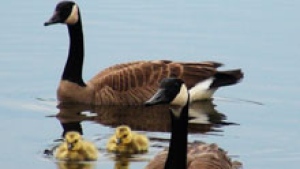An ancient egg-laying mammal has been recorded in a remote part of Indonesia for the first time after scientists thought it had been extinct for decades.
An expedition to Indonesia led by Oxford University researchers recorded four three-second clips of the long-beaked echidna which is named after explorer Sir David Attenborough..
Spiky, furry and with a beak, echidnas have been called “living fossils”.
They are thought to have emerged about 200 million years ago, when dinosaurs roamed the Earth.
Until now, the only evidence that this particular species Zaglossus attenboroughi existed was a decades-old museum specimen of a dead animal.
“I was euphoric, the whole team was euphoric,” Dr James Kempton told BBC News of the moment he spotted the Attenborough echidna in camera trap footage.
“I’m not joking when I say it came down to the very last SD card that we looked at, from the very last camera that we collected, on the very last day of our expedition.”
Dr Kempton said he had been in letter correspondence with Sir David about the rediscovery and that he was “absolutely delighted”.
Dr Kempton, a biologist from Oxford University, headed a multi-national team on the month-long expedition traversing previously unexplored stretches of the Cyclops Mountains, a rugged rainforest habitat 2,000m (6,561ft) above sea level.
In addition to finding Attenborough’s “lost echidna” the expedition discovered new species of insects and frogs, and observed healthy populations of tree kangaroo and birds of paradise.
Aside from the duck-billed platypus, the echidna is the only mammal that lays eggs. Of the four echidna species three have long beaks, with the Attenborough echidna, and the western echidna considered critically endangered.
Previous expeditions to the Cyclops Mountains had uncovered signs, such as ‘nose pokes’ in the ground, that the Attenborough echidna was still living there.
But they were unable to access the remotest reaches of the mountains and provide definitive proof of their existence.
That has meant that for the last 62 years the only evidence that Attenborough echidna ever existed has been a specimen kept under high security in the Treasure Room of Naturalis, the natural history museum of the Netherlands.
The Cyclops Mountains are precipitously steep and dangerous to explore. To reach the highest elevations, where the echidna are found, the scientists had to climb narrow ridges of moss and tree roots – often under rainy conditions – with sheer cliffs on either side. Twice during their ascent the mountains were hit by earthquakes.
“You’re slipping all over the place. You’re being scratched and cut. There are venomous animals around you, deadly snakes like the death adder,” Dr Kempton explains.
“There are leeches literally everywhere. The leeches are not only on the floor, but these leeches climb trees, they hang off the trees and then drop on you to suck your blood.”
Once the scientists reached the higher parts of the Cyclops it became clear the mountains were full of species that were new to science.

“My colleagues and I were chuckling all the time,” Dr Leonidas-Romanos Davranoglou, a Greek insect specialist, said.
“We were so excited because we were always saying, ‘this is new, nobody has seen this’ or ‘Oh my God, I can’t believe that I’m seeing this.’ It was a truly monumental expedition.”
Dr Davranoglou broke his arm in the first week of the expedition but remained in the mountains collecting samples. He says they have already confirmed “several dozen” new insect species and are expecting there to be many more. They also found an entirely new type of tree-dwelling shrimp and a previously unknown cave system.
Gison Morib, a conservationist with Yappenda, a local non-profit that partnered with Oxford University on the expedition, said:
“The top of the Cyclops are really unique. I want to see them protected.
We have to protect these sacred mountains. There are so many endemic species we don’t know.”




